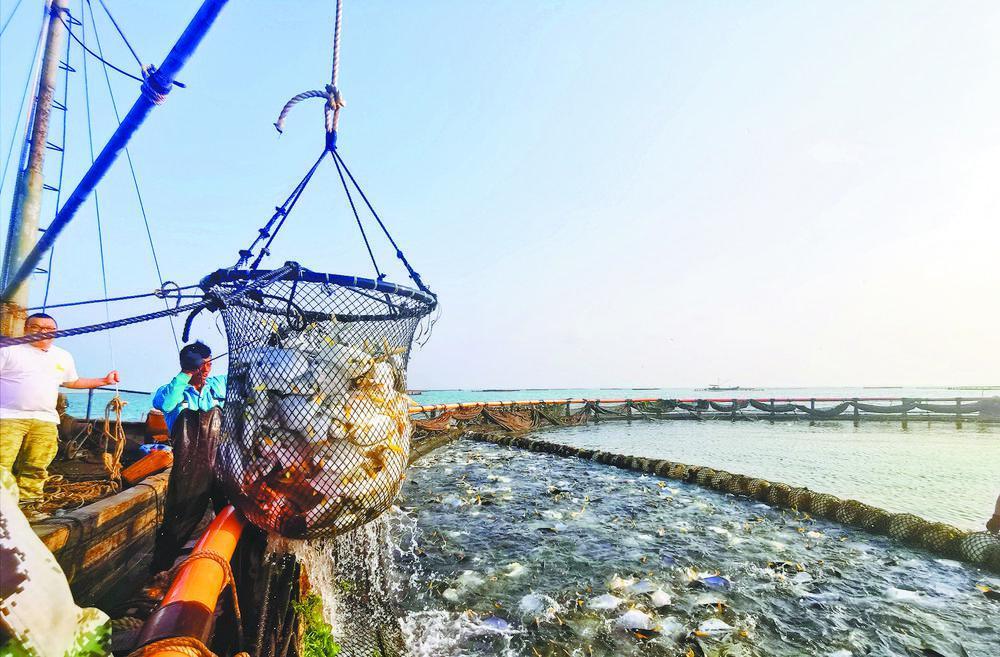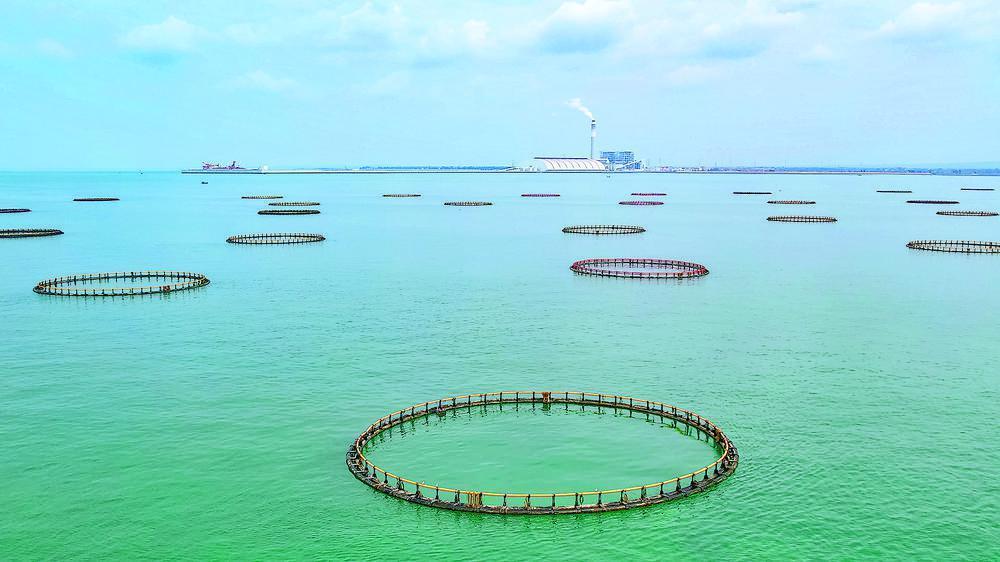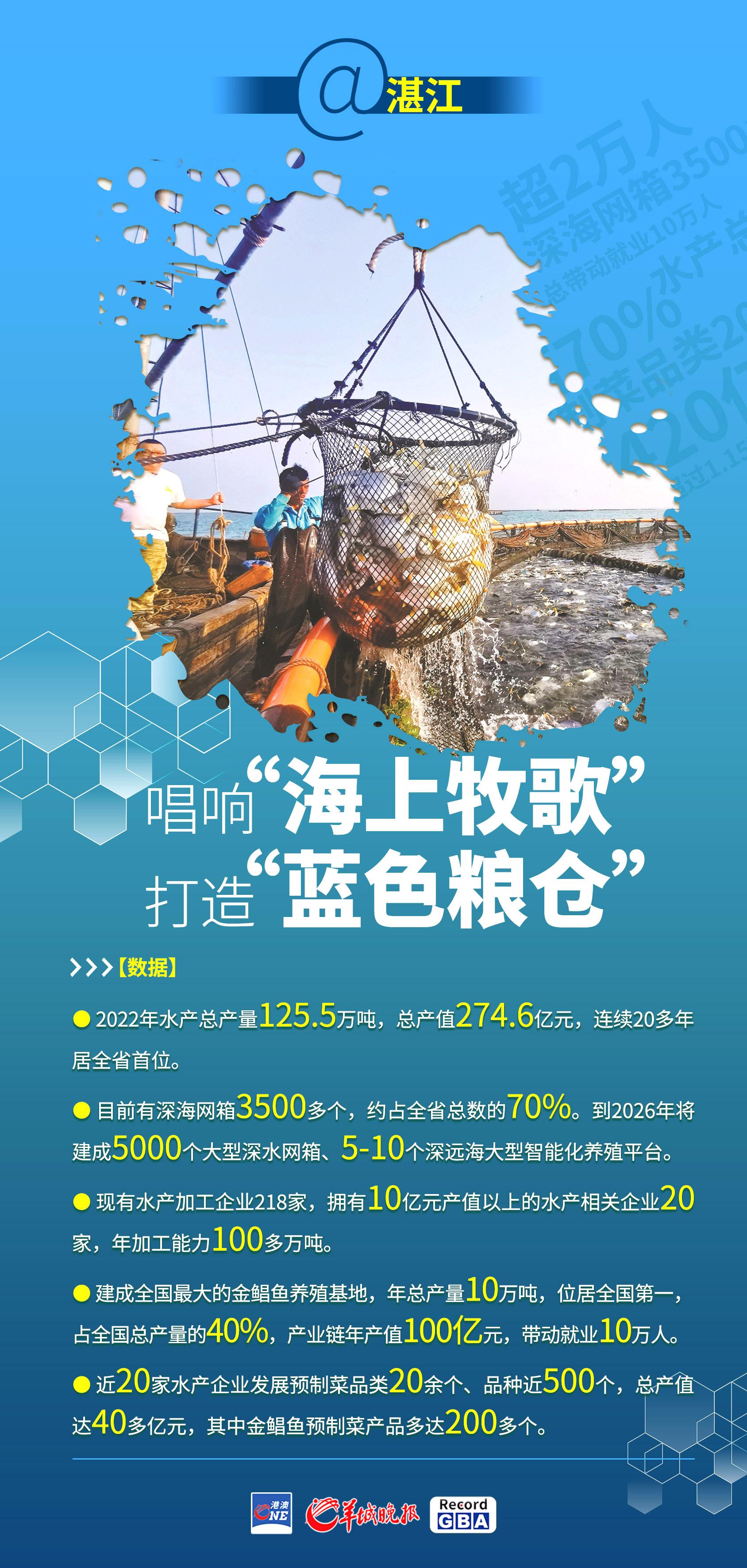Xi Jinping, general secretary of the Communist Party of China Central Committee, on April 10 inspected south China's Guangdong Province.
He first went to the city of Zhanjiang, where he visited a mariculture base, an area of mangrove forests, a port, and a water resource allocation project.
Xi learned about efforts in developing marine aquaculture, strengthening the protection of mangrove forests, boosting transportation infrastructure connectivity, advancing the collaborative development of Guangdong with its neighboring island province of Hainan, and optimizing water resource allocation.
Surrounded by sea on three sides, Zhanjiang, a coastal city with the longest coastline in Guangdong province, refers to the best place naturally to develop marine pastures and "blue granary" in Guangdong.
Blue granary is a national strategy in China targeted at an efficient supply of high-quality protein food, further improving food security. In recent years, with a focus on cultivating a modern industry chain for marine pastures, Zhanjiang strives to develop offshore aquaculture through offshore cages, fish farming vessels and so on, forging a new development model for modern aquaculture in China that is efficient in output, safe in products, and friendly to both resources and environment.
Breeding research to solve the problem of fish seeds
According to the Report to the 20th National Congress of the Communist Party of China, China will "develop the marine economy, protect the marine ecological environment and step up efforts to build China into a strong maritime country." Aligned with such a principle, the development of marine fishing plays an important part in building a strong marine country and ensuring food safety.
Currently, most white shrimps available on the market are native to South America. In 1998, this kind of white shrimps was raised successfully in Zhanjiang, marking the beginning of a north-to-south move for shrimp breeding centers. In 2002, both the Ministry of Science and Technology and the Ministry of Agriculture in China set up a mariculture base under a national-level key project in Zhanjiang to carry out breeding research of South American white shrimps and other aquatic animals.
Driven by such independent breeding work, shrimp farming in Zhanjiang quickly ushered in a blowout. For instance, among cities across the country, Zhanjiang took the lead in seven indicators of seed production, breeding area, breeding production, feed production, processing scale, export volume and trade volume, awarded as "the Capital of Prawns in China". According to statistics, three out of every five shrimp in China comes from Zhanjiang.

Create a modern marine pasture with intelligent technology platform
Blessed with abundant natural resources and a sound industrial basis, Zhanjiang has vigorously developed marine pastures and offshore farming. While creating mangrove forest resorts for tourists, the city also plans to build 5,000 large offshore cages, five to ten large-scale intelligent platforms for offshore fishing, and four national marine pastures by 2026. One classic example is that the production of gold pomfrets by a 100-meter offshore cage can reach 50,000 kilograms, equivalent to a total of 13.3 hectares on land.
Intelligent fisheries also have been on Zhanjiang's agenda in recent years, including the improvement of offshore farming technology and equipment. Liu Ding, chairman of Guangdong Havwii Agriculture Co., Ltd., opened his mobile phone, and then a swimming fish slowly came into the camera. Liu's finger gently slid and the viewpoint switched accordingly. "Everything on our platform can be monitored remotely through the mobile phone." He said.
In the waters of Leizhou Bay, there is a smart fishing system under development and construction, including multi-functional feeding vessels, unattended offshore cages of 60,000 cubic metres , multi-functional vessels with service support, and specialized transport vessels for live fish and feed. Zhang Chunwen, chairman of Zhanjiang Jingwei Industry Co., Ltd., introduced that the intelligent system could achieve precise feeding by setting up a set of accurate feeding plans suitable for a certain area according to different levels of wind and waves. In this way, enough feed for fish without any waste and a pollution-free environment can be achieved simultaneously.
An upgrading industry chain with an annual output value of over 50 billion yuan
The continuous development of Zhanjiang's offshore farming industry leads its whole industry chain in improvement, making it a pillar industry that raises revitalization and prosperity in rural areas.
In recent years, Zhanjiang has continued to expand and strengthen its aquatic products processing industry. In the market of prefabricated food, Zhanjiang has seized the opportunity to introduce relevant policies and measures from production, scientific research, talents, trade, brand and other dimensions, in order to lay a solid foundation for the high-quality development of the prefabricated vegetable industry.
Meanwhile, to create a central kitchen industrial base for pre-made dishes, Zhanjiang has made a lot of efforts, including the building of an industry base for pre-made dishes central kitchen, the setup of a pre-made dishes alliance and a relative industrial association, as well as two pre-made food industrial park of high standards. By far, 12 enterprises have moved in to promote the industrial agglomeration of prefabricated food.What’s more, Zhanjiang has churned out 100,000 tons of pre-made dishes annually with an output value of 5.5 billion yuan, which further polishes its gold-lettered signboard as the "Capital of China's aquatic pre-made dishes".

【Data】
●In 2022, Zhanjiang's total output of aquatic products reached 1.255 million tons with a value of 27.46 billion yuan, ranking first in the Guangdong province for more than 20 consecutive years.
●At present, Zhanjiang has more than 3,500 offshore cages, accounting for about 70 percent of the province's total. By 2026, Zhanjiang will have built 5,000 large offshore cages and 5 to 10 large intelligent farming platforms in the deep and distant sea.
●There are 218 aquatic processing enterprises settled in Zhanjiang, 20 of which have an output value of more than 1 billion yuan with an annual processing capacity of more than 1 million tons.
●Zhanjiang has become the largest gold pomfret breeding base in China, with a total annual production of 100,000 tons, ranking first in China and accounting for 40% of the country's total production. The annual output value of the industrial chain can reach 10 billion yuan, creating 100,000 jobs.
●At present, nearly 20 aquatic enterprises in Zhanjiang have developed over 20 pre-made dishes and nearly 500 varieties (including over 200 pre-made pomfret dishes), with a total output value of over 4 billion yuan.
湛江:唱响“海上牧歌” 打造“蓝色粮仓”
4月10日,习近平总书记在广东省考察调研。他首先来到湛江市,先后考察了国家863计划项目海水养殖种子工程南方基地、麻章区湖光镇金牛岛红树林片区、徐闻港、环北部湾广东水资源配置工程,了解当地发展海洋渔业、加强红树林保护、提升交通基础设施互联互通水平、推动广东海南相向发展、优化水资源配置等情况。
湛江三面环海,海岸线全省最长,是广东发展海洋牧场、打造“蓝色粮仓”的天然主战场。近年来,湛江大力发展深水网箱、养殖工船等深海远海养殖,着力培育现代化海洋牧场全产业链,走出一条“产出高效、产品安全、资源节约、环境友好”的现代水产产业发展新路。
开展育种研发工作 解决渔业种苗问题
“发展海洋经济”“加快建设海洋强国”是党的二十大报告提出的要求。发展海洋渔业,既是建设海洋强国的重要一环,也是确保粮食安全的重要一环。
目前市面上吃到的对虾大多是南美白对虾,1998年南美白对虾在湛江试养成功,我国对虾养殖中心开始由北往南移。2002年,国家科技部、农业部在湛江成立国家863计划海水养殖种子工程南方基地,开展对南美白对虾等水产动物的育种研发工作。
在自主培育南美白对虾的带动下,湛江对虾养殖迅速迎来井喷,种苗产量、养殖面积、养殖产量、饲料产量、加工规模、出口量和交易额七项指标均居全国各地级以上市第一,被称为“全国对虾之都”。据统计,目前全国每5只对虾中就有3只来自湛江。
借助智慧科技平台 打造现代化海洋牧场
依靠海岸线长、海域开阔、水质优、水温和盐度稳定适中等资源禀赋和产业基础优势,湛江大力发展海洋牧场和深远海养殖。根据规划,到2026年,湛江将建成5000个大型深水网箱、5-10个深远海大型智能化养殖平台、4个国家级海洋牧场,同时打造游客向往的“海上草原”。以金鲳鱼为例,一个100米周长的网箱,年产量可达10万斤,相当于陆上200亩池塘的鱼产量。
近年来,湛江大力推动智慧渔业发展,建设完善深远海养殖技术和装备产业全产业链。广东海威农业集团有限公司董事长刘定打开手机,一条鱼缓缓从摄像头前游过,手指轻轻滑动,视角也随之切换。“我们平台上的一切,都可以通过手机远程监控。”他说。
在雷州湾海域,多功能饲料运输船经新型的投喂系统、6万立方米的无人值守养殖网箱、多功能的服务保障支持船、专业化的活鱼运输船、饲料运输船等智慧渔业系统正在研制并搭建。湛江经纬实业有限公司董事长张春文介绍说,智慧渔业系统的饲料精准投喂,可以根据不同海况里的风浪、流向,设置一套适合海区的精准投料方案,既使鱼可以吃饱,又不浪费饲料、污染环境。
全产业链日趋完善 年产值500多亿元
湛江深海养殖产业的不断发展,带动全产业链日趋完善,成为助力乡村振兴、带动农民养殖致富的支柱产业。
近年来,湛江不断做大做强水产加工业。在预制菜的市场,湛江抢抓机遇,出台相关政策措施,从生产、科研、人才、贸易、品牌等多个维度出发,为预制菜产业高质量发展夯实基础。同时,打造预制菜中央厨房产业基地,成立预制菜产业联盟和产业联合会,高标准建设2个预制菜产业园,目前已有12家企业进驻,促进预制菜产业集聚发展。湛江2022年预制菜年产量10万吨,年产值55亿元,进一步擦亮“中国水产预制菜之都”的金字招牌。
【数据】
●2022年水产总产量125.5万吨,总产值274.6亿元,连续20多年居全省首位。
●目前湛江有深海网箱3500多个,约占全省总数的70%。到2026年,湛江将建成5000个大型深水网箱、5-10个深远海大型智能化养殖平台。
●湛江现有水产加工企业218家,拥有10亿元产值以上的水产相关企业20家,年加工能力100多万吨。
●湛江已成为全国最大的金鲳鱼养殖基地,年总产量10万吨,位居全国第一,占全国总产量的40%,产业链年产值100亿元,带动就业10万人。
●目前湛江近20家水产企业发展预制菜品类20余个、品种近500个,总产值达40多亿元,其中金鲳鱼预制菜产品多达200多个。

文 | 戴灵敏 袁增伟 全良波
海报 | 蔡红
翻译 | 陈萱









